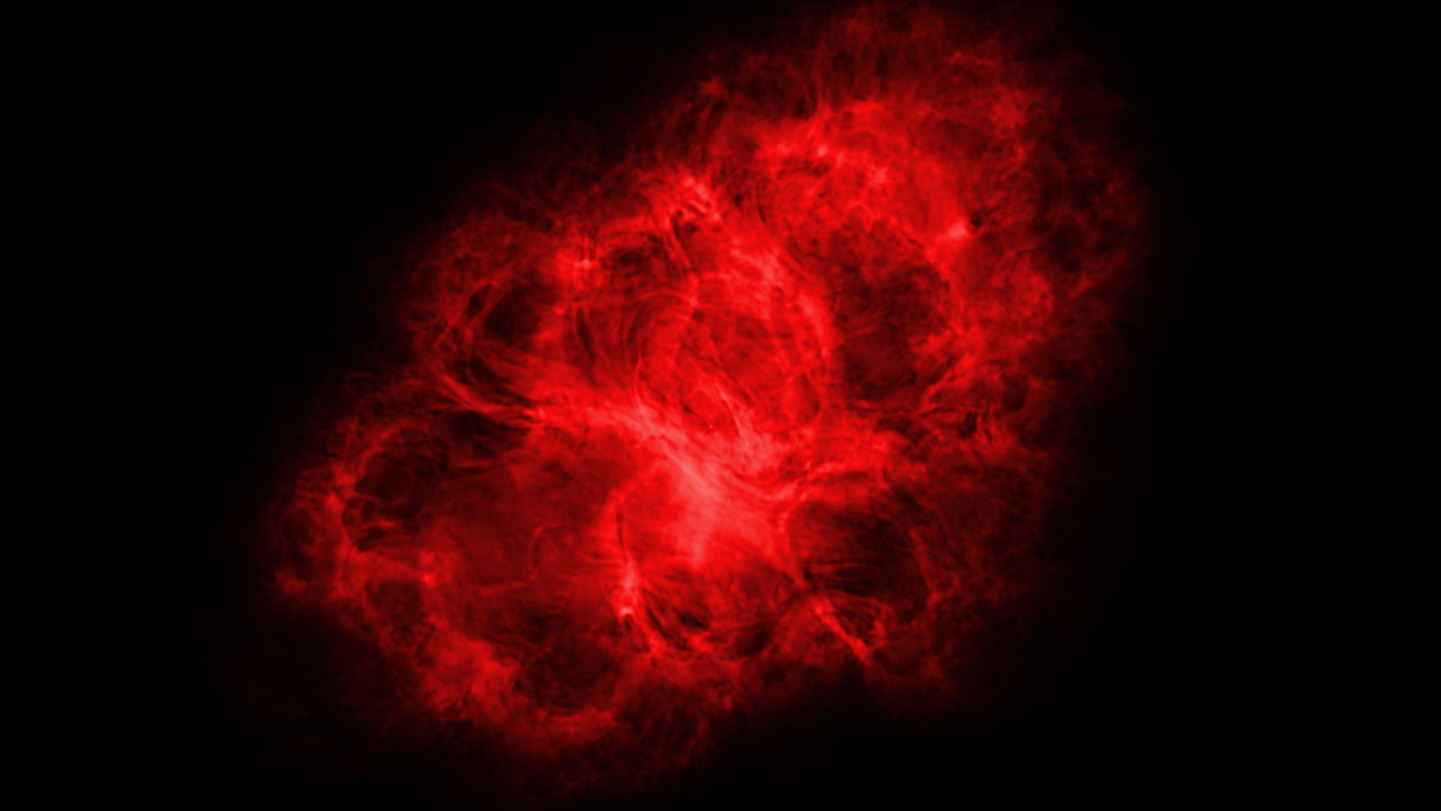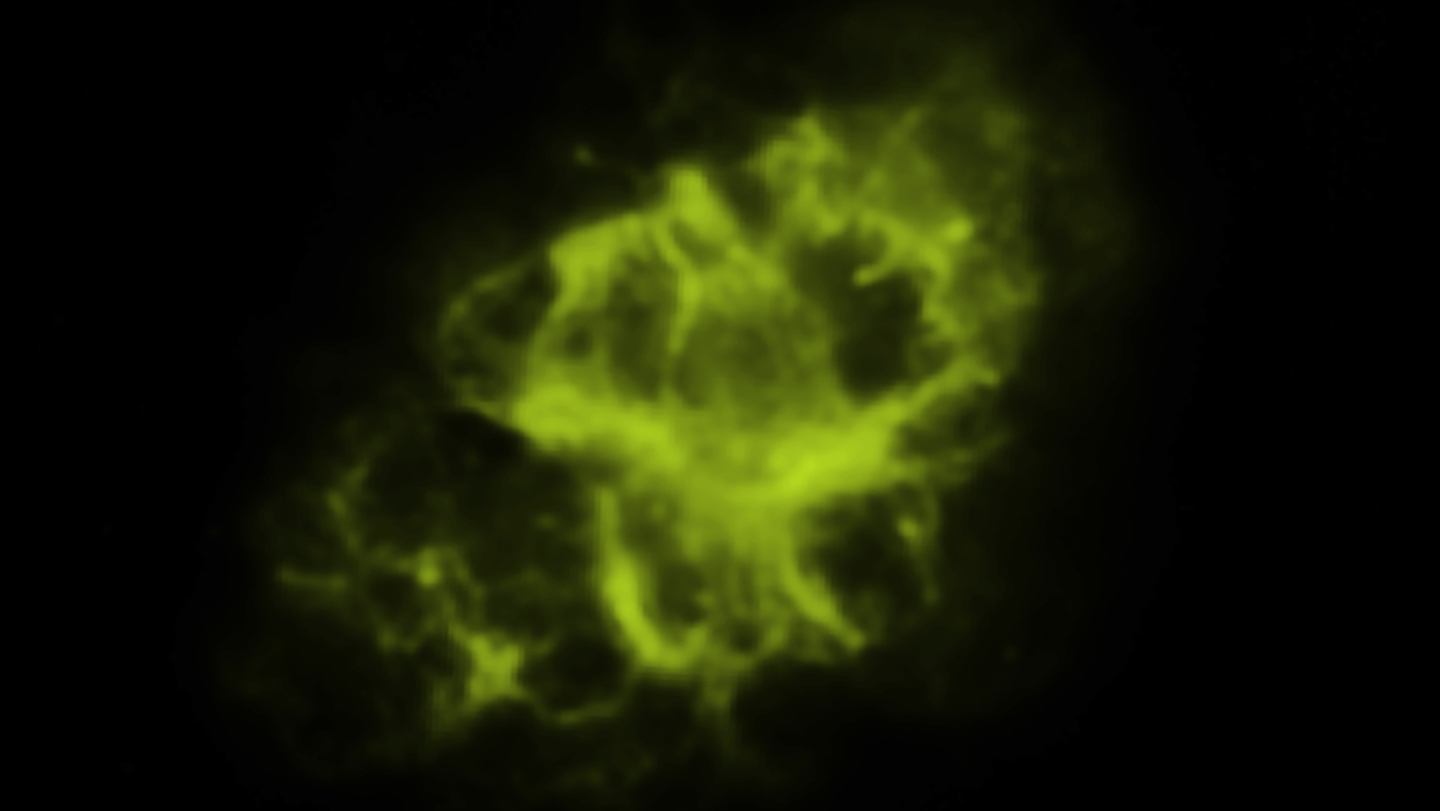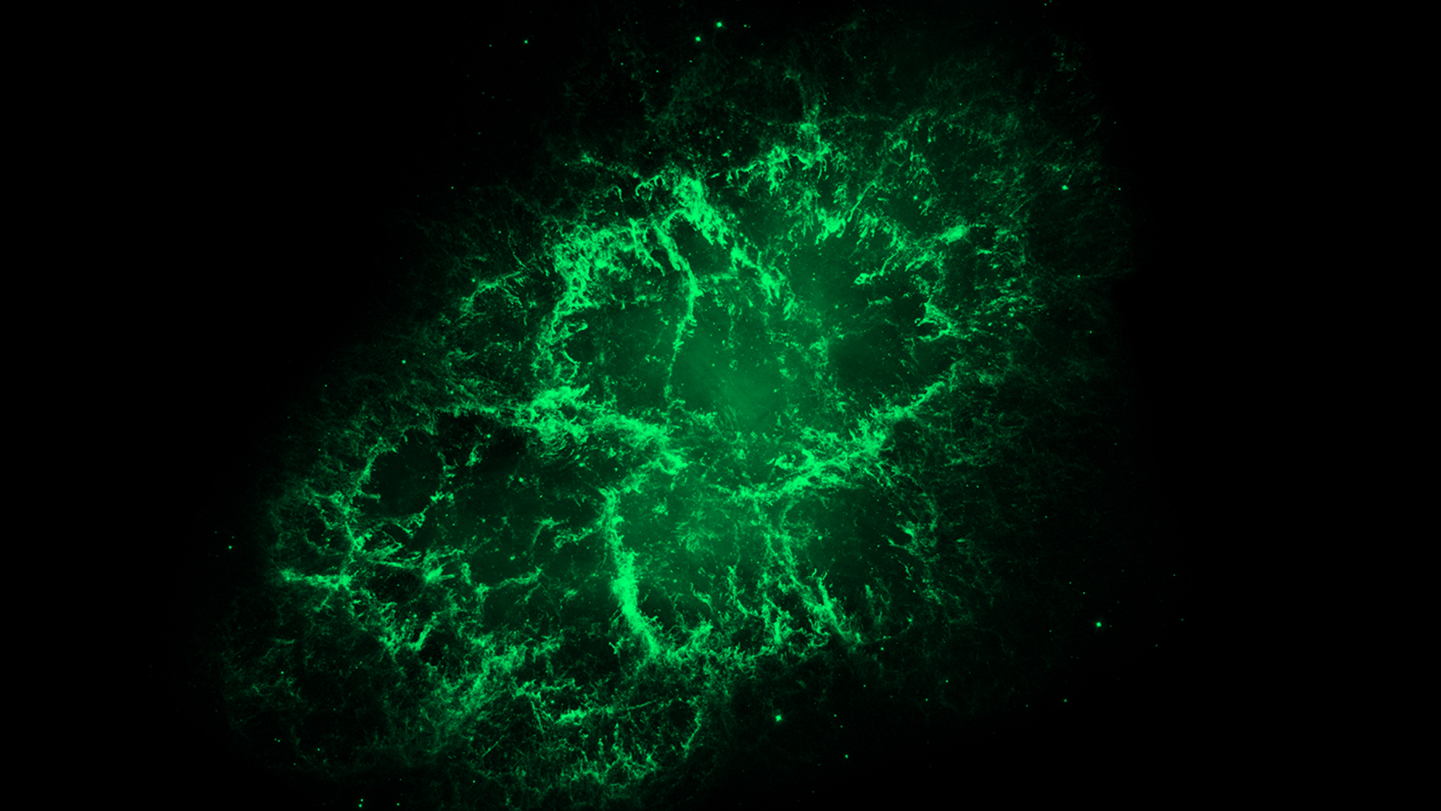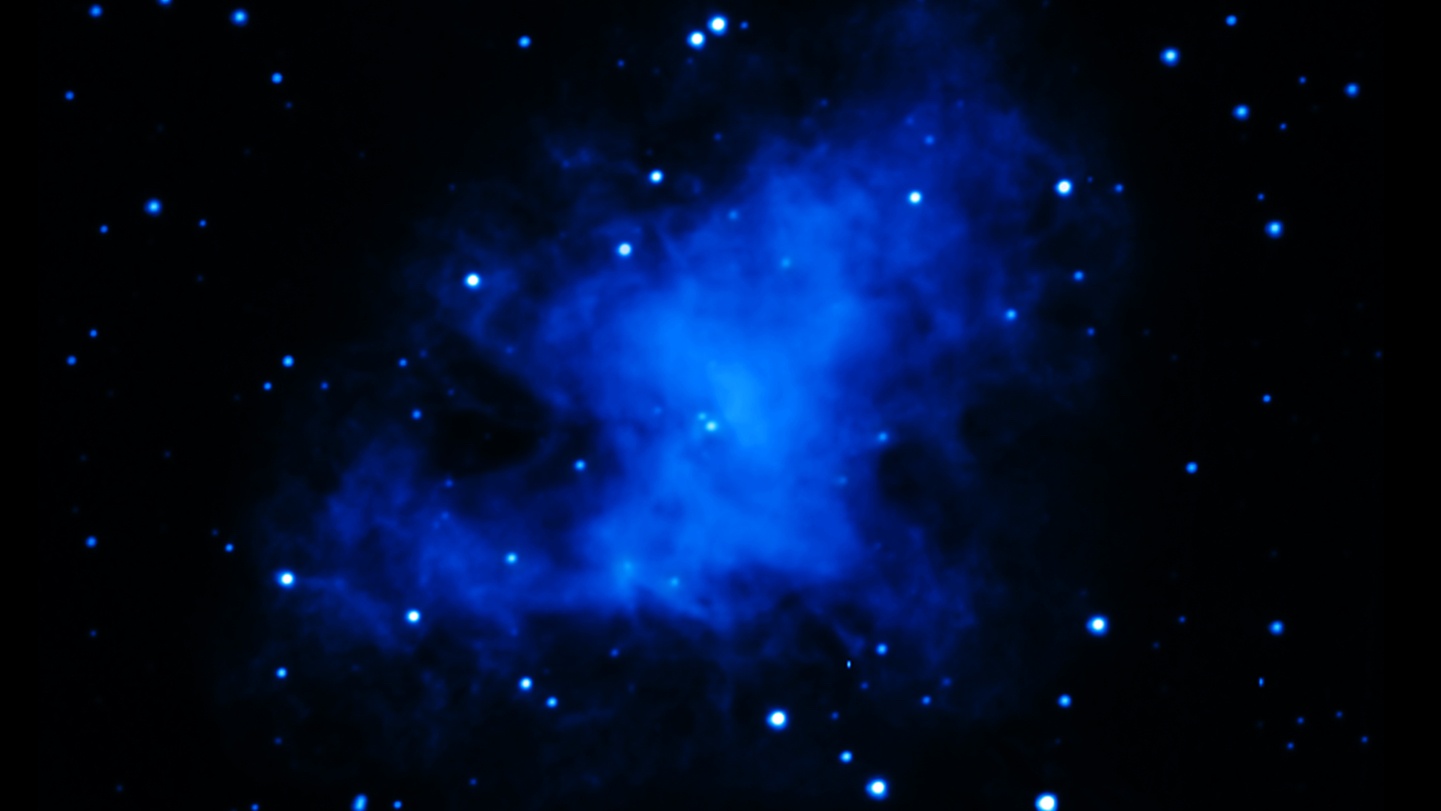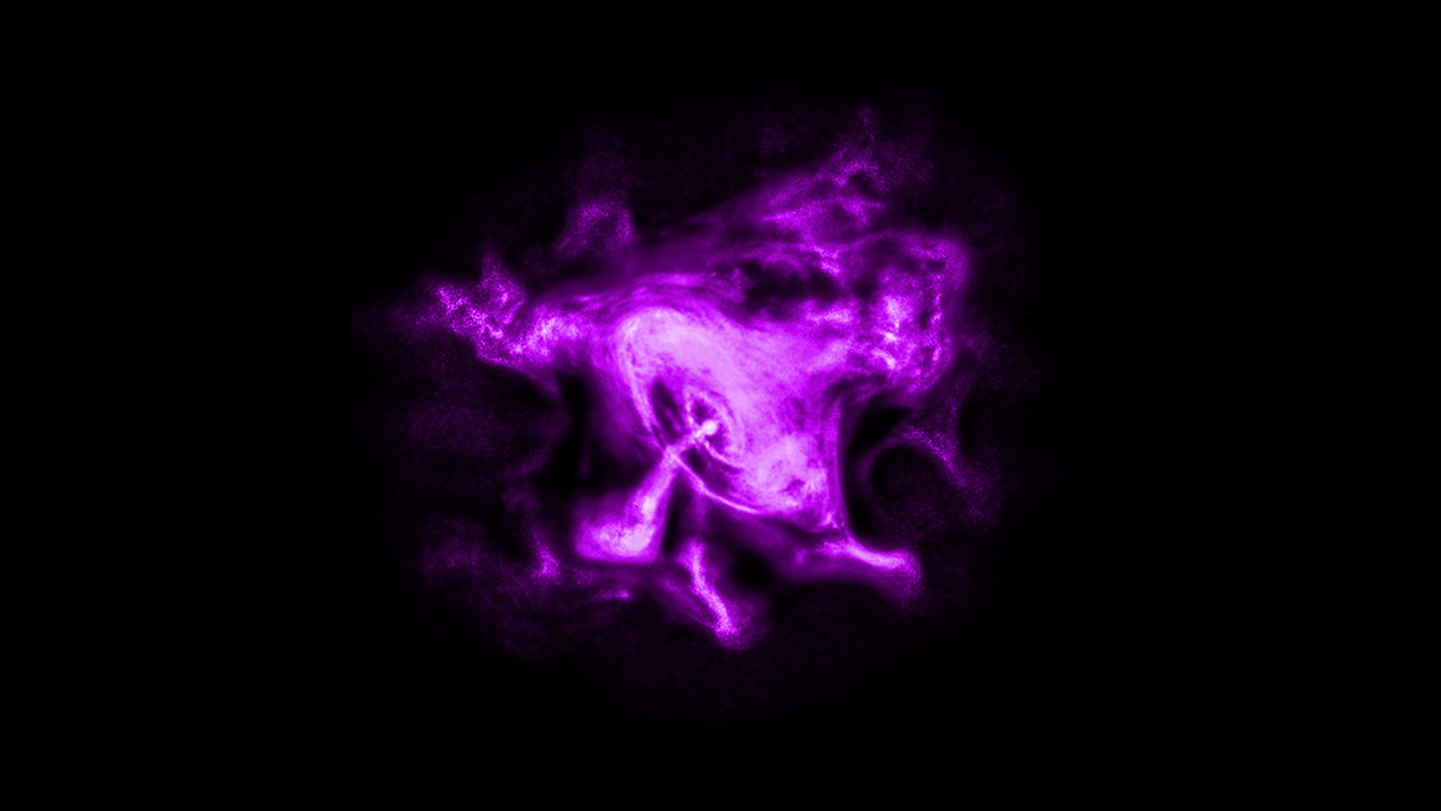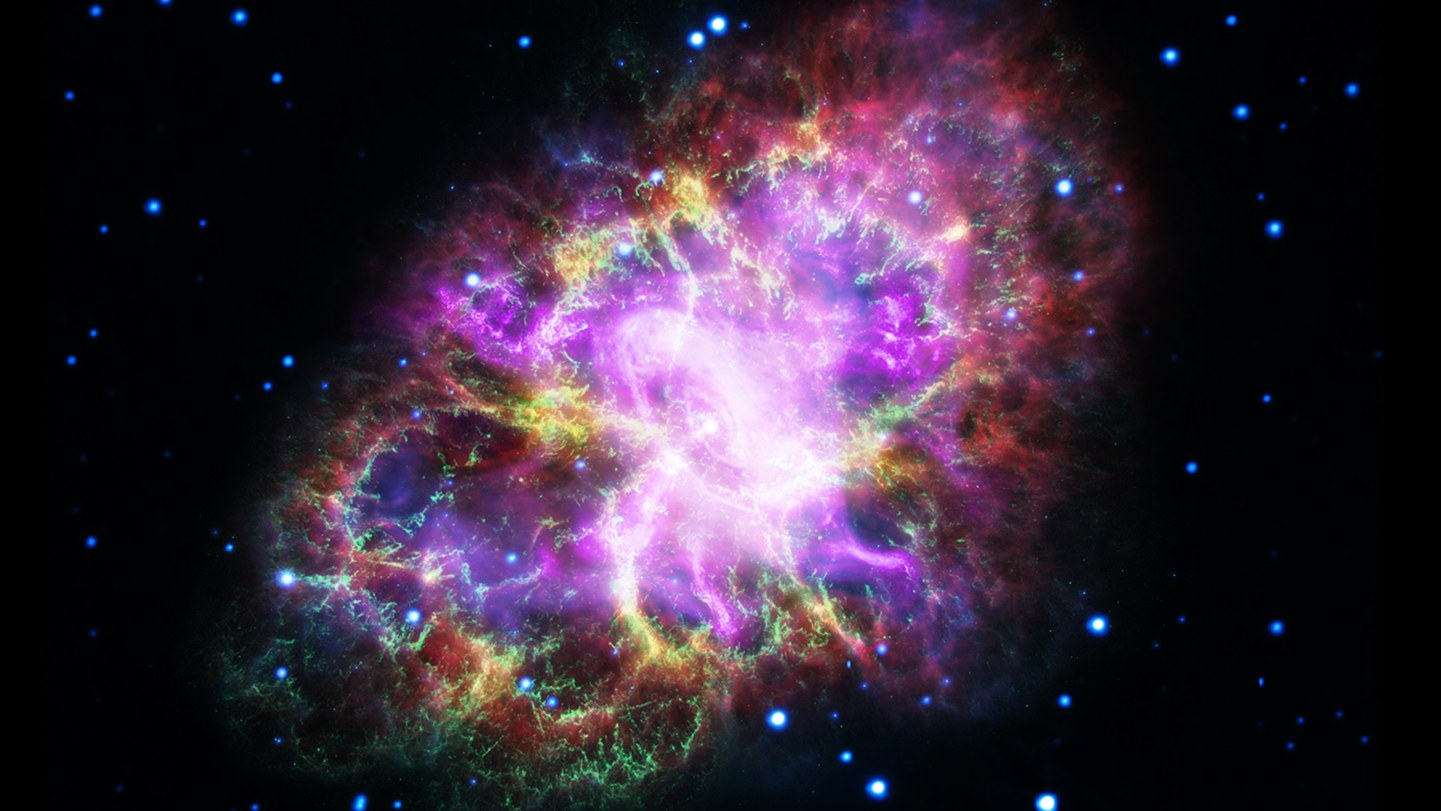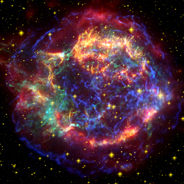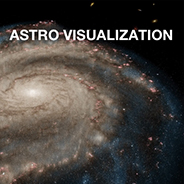Interactive Overview
Slider Interactive: A series of images showing different wavelengths of light emitted by the Crab Nebula. Below the caption is a horizontal slider bar with six labeled stops and a solid white circle. Dragging the white circle right and left along the slider bar causes the image, labels, and caption to change. The change occurs gradually as one image, along with its associated captions and labels, fades out and the next fades in. A toggle button to the upper right of the image turns the image labels off and on. Labels are in the form of text with arrows pointing to specific features in the image.
Slider Stops
From left to right, the slider stops are labeled: Radio, Infrared, Visible, Ultraviolet, X-ray, and Multi-wavelength.
Summary of Slider Stops
Sliding left to right reveals the following:
- “Radio” stop shows the Crab Nebula as looping wisps and filaments of red.
- “Infrared” stop shows the nebula as a blurry yellow-green.
- “Visible” stop shows the nebula as green filaments, resembling paint splatters. This is the initial image shown when the interactive is loaded.
- “Ultraviolet” stop shows the nebula as a wispy, smoke-like cloud of blue.
- “X-ray” stop shows the nebula as swirling wisps, clouds, and jets of purple.
- “Multi-wavelength” stop shows a composite of the images in the other five stops.
The shape of the nebula changes gradually when sliding between radio, infrared, and visible, and when sliding between ultraviolet and X-ray. The shape changes significantly when sliding between visible and ultraviolet.
Stop 1: Radio
Image Description: Radio
Radio waves emitted by the Crab Nebula are shown in red against a black background, forming a large oblong structure oriented at an angle of about 45 degrees clockwise from vertical. The structure (the nebula) is filled with overlapping loops of interwoven wisps and filaments of bright red around darker pockets. The nebula is brightest and densest at the center, generally decreasing in brightness toward the edges.
Labels: Radio
There are two text labels. A bright portion near the top is labeled “Energy from spiraling particles.” A bright thick looping strand toward the bottom is labeled “Magnetic field lines traced by high-energy particles.”
Caption: Radio
Charged particles emit radiation as they move at very high speeds along spiraling paths, guided by magnetic forces.
Stop 2: Infrared
Image Description: Infrared
Infrared light emitted by the Crab Nebula is shown in yellow-green, forming an oblong structure similar to that shown in the radio image, but smaller. The nebula has a similar pattern of bright clouds and dark empty-looking pockets, but the texture appears much smoother and less detail is visible. The bright yellow-green areas and dark pockets in this image correspond roughly to the bright red areas and dark pockets on the radio image.
Labels: Infrared
One text label pointing toward the bright yellow-green reads “Dust from the exploding star.”
Caption: Infrared
Dust that formed from the star may eventually become part of a new star or planet.
Stop 3: Visible
Image Description: Visible
Visible light emitted by the Crab Nebula shown in green against a black background, forms an oblong structure similar in shape and size to that shown in the infrared image, but with more detail and a more defined texture. The nebula has the general appearance of a large splatter of paint, but with a clear radial structure of bright, sharply defined filaments pointing toward the center and interwoven strands arcing around the center. The bright green filaments and strands correspond to the bright areas in the radio and infrared images. In the central region of the nebula, overprinted on the distinct filamentous structure, is a faint green haze that disappears toward the edges. A few points of light dot the black background.
Labels: Visible
One text label, pointing toward a bright feature, reads “Filaments of gas blown out from the star.”
Caption: Visible
The cloud of hot gas blown out from the star is still expanding outward.
Stop 4: Ultraviolet
Image Description: Ultraviolet
Ultraviolet light emitted by the Crab Nebula appears as a blue, wispy, smoke-like haze on a black background scattered with blue-white dots. The hazy blue cloud is irregular in shape. It fills much of the upper-right half of the oblong structure apparent in the radio, infrared, and visible images, but only some of the lower-left half. It is brighter near the center and grows dimmer toward the edges. At the center of the structure is a small bright dot with very subtle rings of blue haze surrounding it.
Labels: Ultraviolet
There are two text labels. The main blue smoke-like cloud in the center is labeled “Hot gas energized by the central neutron star.” One of the small blue-white dots toward the bottom right of the image, outside of the blue cloud, is labeled “Other stars.”
Caption: Ultraviolet
Stars outside the nebula are made of atoms created and expelled by earlier generations of stars.
Stop 5: X-ray
Image Description: X-ray
X-ray light emitted by the Crab Nebula is shown in purple on a black background. The purple forms an irregular shape with a similar footprint to the blue in the ultraviolet image. The structure is more distinct, with more color contrast. In the center is a small purple-white spot surrounded by distinct concentric circles that form a disk-like shape. They form two concentric rings, a sharper inner ring with bright knots and a more diffuse outer ring. A beam of purple projects from the bottom of the purple-white spot down toward the lower left, expanding to form a slightly bent jet. Surrounding the top of the disk-like region are wispy, swirling plumes of purple, some of which arc around dark pockets.
Labels: X-ray
There are three text labels. The bright white-purple spot in the center is labeled “Neutron star at the core.” The disk-like structure of concentric circles surrounding the bright spot is labeled “Rings of high-energy particles.” The beam that projects from the bright spot toward the lower left is labeled “Jet of high-energy particles.”
Caption: X-ray
Particles caught in the magnetic field of the dead star’s core (a small, dense, spinning ball of neutrons) shine in X-rays.
Stop 6: Multi-wavelength
Image Description: Multi-wavelength
This is a composite of the other five images, with the different forms of light emitted by the Crab Nebula shown in different colors. The colors are the same as in the individual images: radio in red, infrared in yellow-green, visible in green, ultraviolet in blue, and X-ray in purple. Throughout the image, these colors overlap and combine in different ways to form other colors. The structures shown in the previous stops are still apparent, but they combine to form a much more complex structure.
On the nebula’s exterior, toward the bottom left, are clumpy filaments of green. At the top and left of the image is fluffy red-brown material. Interior to this outer shell lies a ring of mottled filaments of yellow and bright purple studded with clumps and knots. Small translucent wisps of blue, purple, and red appear throughout the image. The nebula lies against a black background that is scattered with small blue-white points of light.
Labels: Multi-wavelength
There are three text labels. Toward the top, an area of thin, yellowish-green ridge-like lines is labeled “Dust.” A hazy green filament in the bottom left area of the object is labeled “Gas.” The bright purple spot at the center is labeled “Stellar corpse.”
Caption: Multi-wavelength
A composite image of visible and invisible light shows the remains of a star nearly 1,000 years after it exploded.
